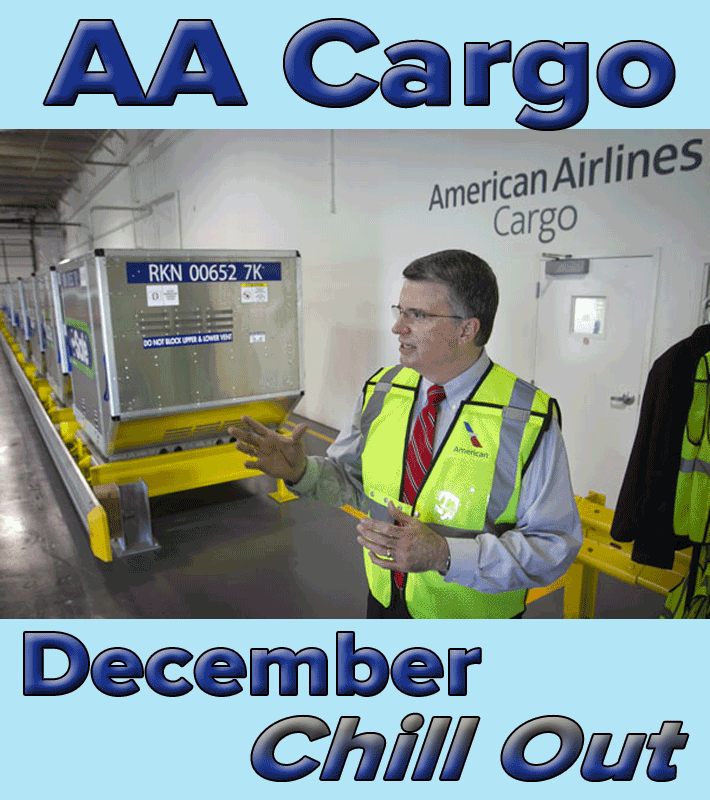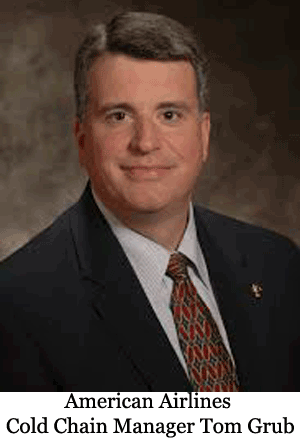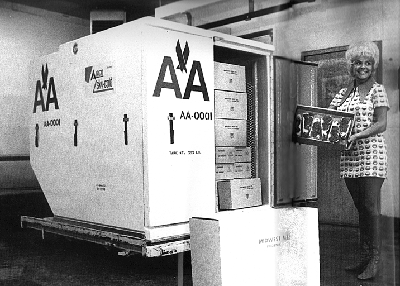
With the year nearing its close, we’re taking a moment to look back at 2015 and ahead to 2016 with Tom Grubb, American Airlines Manager Cold Chain Strategy.
“The year 2015 has been a very busy year for all of the numerous activities related to our merger finalization as well as cold chain initiatives.
“A key innovation is our Philadelphia Pharma facility, which celebrated its grand opening earlier this year.
“It is a 25,000-square-foot, dedicated pharmaceutical and healthcare handing facility—the first of its kind for a passenger air carrier in the NE region of the United States.
“AA Cargo Philadelphia features 9,000-square-feet of controlled storage, including 6,000-square-feet of Controlled Room Temperature (CRT) +15°C to +25°C, and 3,000-square-feet of Cold Storage (COL) +2°C to +8°C.
“There is an Active Container Management (ACM) area where we have capacity to simultaneously recharge up to 30 RKNs and the facility has full monitoring and emergency power backup generation capabilities.”
Key Corridor 
“Our facility is situated in the heart of a key U.S. pharmaceutical corridor, which serves customers from Pennsylvania to Maine and is an ideal hub for access to American’s network between Europe, North America, Latin America, and beyond.
“This NE corridor contains numerous research and development as well manufacturing facilities for many of the world’s top pharma companies.
“A healthcare logistics hub such as this gives customers unprecedented access to quality handling and transportation for their temperature-sensitive healthcare products.”
American’s cargo customers include Teva Pharmaceutical Industries, Pfizer, Merck, Astra Zeneca, Novartis, Bayer, GlaxoSmithKline, and Ivax, American said.
Enhanced Network
“As was the case with the PHL facility, we continue to evaluate network infrastructure and process enhancements in order to keep ExpediteTC° the premier solution for temperature-controlled shipping of delicate pharmaceutical and healthcare products.
“We continue to invest in our ExpediteTC° program as traffic in the last several years has grown significantly.
“Coupled with positive industry feedback on our infrastructure, equipment, and process enhancements, we see continuing demand for this key vertical.
“This sector will continue to become more and more important, particularly with the increased demand for advances in the temperature-controlled service offerings.
“Advances are driven largely due to both increasing product complexities and more stringent regulatory requirements for the supply chain.”
First He Built It
Tom Grubb has served as manager of cold chain strategy, leading the strategic oversight of American’s time- and temperature-sensitive cargo services since the post was created in 2011.
A longtime veteran of American’s Cargo division, Mr. Grubb was pivotal in the development of American’s existing cold chain service, ExpediteTC°.
One thing we liked immediately that brought Tom to our attention was a session he was involved in last year in Boston at the IQPC GDP and Temperature Management Logistics Global Forum.
American’s session at that event focused on the relationship between the pharmaceutical manufacturer, the freight forwarder, and the air carrier, but the star was clearly the leadership, which put heads and hands together to work through the critical elements in the shipping process.
Thought Leaders
The presentation was a best practices case study demonstrating how stakeholders should work together for success. Perspectives reflected in the session were presented by pharmaceuticals manufacturer Jim Bacon of Grifols Inc., freight forwarder Kris Hembree of Uti, and Tom Grubb.
“Better solutions for proper management of cold chain are developed through proactive communication and information sharing,” the group concluded.
“This includes thorough understanding of product requirements, identification and implementation of best practices, creation of detailed SOPs, and insuring each participant’s complete understanding of the process.
“Process Development, each stakeholder, by bringing their unique perspectives to the table, jointly developed a solution which resulted in successful implementation and execution.”
(More: https://www.aacargo.com/about/tradeshows/iqpc.html)
What Lies Ahead?
“According to IATA, global pharmaceutical and healthcare logistics spend was approximately $8.5B in 2014—that number is expected to increase to $10.0B by 2018,” Tom Grubb said.
“Increasing regulatory oversight and corresponding customer expectations are clearly resulting in the demand for enhanced control necessary for transportation of advanced biologics.
“These treatments include such products as vaccines, somatic cells, and gene therapies; the trend in handling of these delicate pharma products will continue to expand.
“Earlier this year American Airlines Cargo announced it is the first U.S.-based passenger carrier to receive official approval to carry the full suite of Envirotainer products for customers.
“The RKN e1 and the larger RAP e2 are active, temperature-controlled containers designed to provide the superior protection necessary for the safe global shipment transportation of highly-sensitive healthcare products destined for patients around the world.
“Using compressor cooling and electric heating, the e1 and e2 containers are outstanding for shipments requiring added enhanced temperature control.
“American began accepting shipments with these containers on November 1.”
Healthcare To The World
“Coupled with the CSafe RKN as well as the numerous Passive options available to shippers, our ExpediteTC° program processes and infrastructure are designed with quality in mind for the safe movement of delicate pharmaceutical and healthcare products.
“Combined with our new aircraft arriving every day, our capabilities continue to expand, providing added network opportunities to customers wanting to ship pharma anywhere within our global network.”
The Big Picture
“American remains dedicated to ensuring that our time and temperature-sensitive services meet customer expectations for both the manufacturer and logistics customers, but, most importantly, for the patient at the end of the supply chain.
“Unlike other shipment types, pharmaceutical and healthcare customers rely most heavily on us to provide a consistent, transparent, and quality experience for each product they trust us to carry on our planes.
“It is very important to ensure open lines of communication between the shippers, forwarders, and airlines in order to ensure complete understanding and agreement on the roles and responsibilities of each partner.
“Expanding use of the collaborative approach assures transparency and open communication, and minimizes challenges which can affect quality in the temperature-controlled supply chain,” Tom Grubb said.
Geoffrey |



